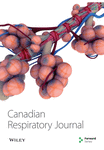High Probability Ventilation-Perfusion Scan in Primary Pulmonary Hypertension
Abstract
The perfusion lung scan is a valuable noninvasive tool in the evaluation of patients with pulmonary arterial hypertension of undetermined cause and for the exclusion of occult large-vessel pulmonary thromboembolism. Peripheral patchy defects have been reported in primary pulmonary hypertension (PPH) but there are no well documented reports of segmental or larger perfusion defects. A case of a 55-year-old male with severe pulmonary hypertension of unknown etiology who had persistent high probability perfusion scan patterns over a period of two years is reported. No evidence of thromboembolism was present on pulmonary angiography. A discussion of the case and a review of the literature on the role of lung scan in PPH are presented. Most patients with PPH have normal or low probability perfusion scans; high probability scans occur rarely.




